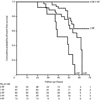Genetics and genetic testing of dilated cardiomyopathy: a new perspective
- PMID: 23375013
- PMCID: PMC3929942
Genetics and genetic testing of dilated cardiomyopathy: a new perspective
Abstract
The completion of the Human Genome Project was a landmark achievement, but as clinical genetic testing becomes more mainstream, the extent of remarkable genetic variation is increasingly being appreciated. Newer DNA sequencing technology can now complete the sequencing of an entire human genome several times over in a matter of days, but this will undoubtedly add new challenges to the difficulty of distinguishing true pathogenic variants from benign variants in diagnostic genetics and in the research setting. The recent discovery of the role of titin gene (TTN) mutations in dilated cardiomyopathy (DCM) will make genetic testing in this disease more efficient. Furthermore, better understanding of genotype-phenotype associations will assist clinicians in identifying early stages of disease and providing more appropriate treatments. This high level of complexity requires an expert genetic team to offer counseling and to manage, deliver, and follow-up over time the results of genetic testing, which is particularly important for screening of family members potentially at risk. In DCM, genetic testing may be useful for the identification of non-carriers and asymptomatic carriers, as well as for prevention strategies, sport recommendations, and defibrillator implantation. It can also guide reproductive decision-making including utilization of pre-implantation genetic diagnostic strategies.
Conflict of interest statement
The authors declare that there are no conflicts of interest, grants, or relationship with industry.
Figures



Similar articles
-
Genetic evaluation of dilated cardiomyopathy.Curr Cardiol Rep. 2013 Jul;15(7):375. doi: 10.1007/s11886-013-0375-1. Curr Cardiol Rep. 2013. PMID: 23686784 Review.
-
Exome sequencing and genome-wide linkage analysis in 17 families illustrate the complex contribution of TTN truncating variants to dilated cardiomyopathy.Circ Cardiovasc Genet. 2013 Apr;6(2):144-53. doi: 10.1161/CIRCGENETICS.111.000062. Epub 2013 Feb 15. Circ Cardiovasc Genet. 2013. PMID: 23418287 Free PMC article.
-
Identification of a novel frameshift mutation in the giant muscle filament titin in a large Australian family with dilated cardiomyopathy.J Mol Med (Berl). 2006 Jun;84(6):478-83. doi: 10.1007/s00109-006-0060-6. Epub 2006 May 6. J Mol Med (Berl). 2006. PMID: 16733766
-
Clinical Considerations for a Family with Dilated Cardiomyopathy, Sudden Cardiac Death, and a Novel TTN Frameshift Mutation.Int J Mol Sci. 2021 Jan 12;22(2):670. doi: 10.3390/ijms22020670. Int J Mol Sci. 2021. PMID: 33445410 Free PMC article.
-
Role of titin in cardiomyopathy: from DNA variants to patient stratification.Nat Rev Cardiol. 2018 Apr;15(4):241-252. doi: 10.1038/nrcardio.2017.190. Epub 2017 Dec 14. Nat Rev Cardiol. 2018. PMID: 29238064 Review.
Cited by
-
A common polymorphism in the SCN5A gene is associated with dilated cardiomyopathy.J Cardiovasc Med (Hagerstown). 2018 Jul;19(7):344-350. doi: 10.2459/JCM.0000000000000670. J Cardiovasc Med (Hagerstown). 2018. PMID: 29782370 Free PMC article.
-
Drug Development and the Use of Induced Pluripotent Stem Cell-Derived Cardiomyocytes for Disease Modeling and Drug Toxicity Screening.Int J Mol Sci. 2020 Oct 3;21(19):7320. doi: 10.3390/ijms21197320. Int J Mol Sci. 2020. PMID: 33023024 Free PMC article. Review.
-
GRINL1A Complex Transcription Unit Containing GCOM1, MYZAP, and POLR2M Genes Associates with Fully Penetrant Recessive Dilated Cardiomyopathy.Front Genet. 2021 Nov 25;12:786705. doi: 10.3389/fgene.2021.786705. eCollection 2021. Front Genet. 2021. PMID: 34899865 Free PMC article.
-
Biallelic loss-of-function in NRAP is a cause of recessive dilated cardiomyopathy.PLoS One. 2021 Feb 3;16(2):e0245681. doi: 10.1371/journal.pone.0245681. eCollection 2021. PLoS One. 2021. PMID: 33534821 Free PMC article.
-
Diagnosis, prevalence, and screening of familial dilated cardiomyopathy.Expert Opin Orphan Drugs. 2015;3(8):869-876. doi: 10.1517/21678707.2015.1057498. Epub 2015 Jun 22. Expert Opin Orphan Drugs. 2015. PMID: 27547593 Free PMC article.
References
-
- Ackerman MJ, Priori SG, Willems S, Berul C, Brugada R, Calkins H, Camm AJ, Ellinor PT, Gollob M, Hamilton R, Hershberger RE, Judge DP, Le Marec H, McKenna WJ, Schulze-Bahr E, Semsarian C, Towbin JA, Watkins H, Wilde A, Wolpert C, et al. HRS/EHRA expert consensus statement on the state of genetic testing for the channelopathies and cardiomyopathies: this document was developed as a partnership between the Heart Rhythm Society (HRS) and the European Heart Rhythm Association (EHRA) Heart Rhythm. 2011;8(8):1308–1339. - PubMed
-
- Bick AG, Flannick J, Ito K, Cheng S, Vasan RS, Parfenov MG, Herman DS, Depalma SR, Gupta N, Gabriel SB, Funke BH, Rehm HL, Benjamin EJ, Aragam J, Taylor HA, Jr, Fox ER, Newton-Cheh C, Kathiresan S, O’Donnell CJ, Wilson JG, et al. Burden of rare sarcomere gene variants in the Framingham and Jackson Heart Study cohorts. Am J Hum Genet. 2012;91(3):513–519. - PMC - PubMed
-
- Charron P, Arad M, Arbustini E, Basso C, Bilinska Z, Elliott P, Helio T, Keren A, McKenna WJ, Monserrat L, Pankuweit S, Perrot A, Rapezzi C, Ristic A, Seggewiss H, Van Langen I, Tavazzi L. Genetic counseling and testing in cardiomyopathies: a position statement of the European Society of Cardiology Working Group on Myocardial and Pericardial Diseases. Eur Heart J. 2010;31(22):2715–2726. - PubMed
-
- Gerull B, Gramlich M, Atherton J, McNabb M, Trombitas K, Sasse-Klaassen S, Seidman J, Seidman C, Granzier H, Labeit S, Frenneaux M, Thierfelder L. Mutations of TTN, encoding the giant muscle filament titin, cause familial dilated cardiomyopathy. Nat Genet. 2002;30:201–204. - PubMed
-
- Guo W, Schafer S, Greaser ML, Radke MH, Liss M, Govindarajan T, Maatz H, Schulz H, Li S, Parrish AM, Dauksaite V, Vakeel P, Klaassen S, Gerull B, Thierfelder L, Regitz-Zagrosek V, Hacker TA, Saupe KW, Dec GW, Ellinor PT, et al. RBM20, a gene for hereditary cardiomyopathy, regulates titin splicing. Nat Med. 2012;18(5):766–773. - PMC - PubMed
Publication types
MeSH terms
Substances
Grants and funding
LinkOut - more resources
Full Text Sources
Medical

